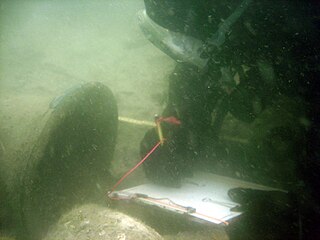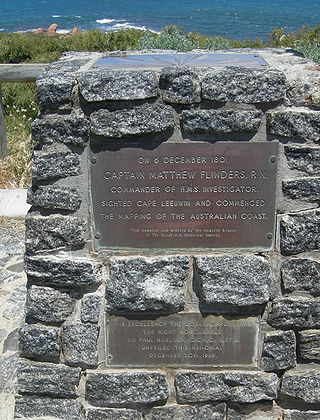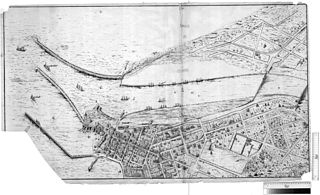
Maritime archaeology is a discipline within archaeology as a whole that specifically studies human interaction with the sea, lakes and rivers through the study of associated physical remains, be they vessels, shore-side facilities, port-related structures, cargoes, human remains and submerged landscapes. A specialty within maritime archaeology is nautical archaeology, which studies ship construction and use.

SS Yongala was a passenger steamship that was built in England in 1903 for the Adelaide Steamship Company. She sank in a cyclone off the coast of Queensland in 1911, with the loss of all 122 passengers and crew aboard.

Flinders Bay is a bay in western Australia, immediately south of the townsite of Augusta, and close to the mouth of the Blackwood River.
The Western Australian Museum is a statutory authority within the Culture and the Arts Portfolio, established under the Museum Act 1969.
Over 1400 ships have been wrecked on the coast of Western Australia. This relatively large number of shipwrecks is due to a number of factors, including:

HMS Roebuck was a fifth-rate warship in the Royal Navy which, under the command of William Dampier, carried the first British scientific expedition to Australia in 1699. It sank in early 1701. The wreck of the ship has since been located by a team from the Western Australian Maritime Museum at a site on the coast of Ascension Island where it foundered more than 300 years ago.

The Sydney Harbour anti-submarine boom net was an anti-torpedo and submarine defence net that was in Sydney Harbour during World War II. It spanned the entire width of the harbour from Laing Point, Watsons Bay to Georges Head Battery, on the northern side of Sydney Harbour. The boom formed part of the Sydney Harbour defences which also included artillery batteries and patrol boats.

Challenger Harbour is a marina in Fremantle, Western Australia adjacent to the Fremantle Fishing Boat Harbour. The harbour breakwater covers the historical site of the Fremantle Long Jetty.

The Port of Albany is located within Princess Royal Harbour in King George Sound on the south coast of Western Australia, in the Great Southern region.

Fremantle Harbour is Western Australia's largest and busiest general cargo port and an important historical site. The inner harbour handles a large volume of sea containers, vehicle imports and livestock exports, cruise shipping and naval visits, and operates 24 hours a day. It is located adjacent to the city of Fremantle, in the Perth metropolitan region.

Louis Francois Marie Aleno de Saint Aloüarn was a French Navy officer and explorer who claimed French Western Australia.
SS Xantho was a steam ship used in the colony of Western Australia as a pearling transport and mothership, as a tramp steamer, carrying passengers, including Aboriginal convicts and trade goods before she sank at Port Gregory, Western Australia in 1872. She was powered by a horizontal trunk engine, and was the first steamship to operate in north-western Australia.

The Belitung shipwreck is the wreck of an Arabian dhow which sank around 830 AD. The ship completed the outward journey from Arabia to China, but sank on the return journey from China, approximately 1.6 kilometres (1 mi) off the coast of Belitung Island, Indonesia. It is unclear why the ship was south of the typical route when it sank. Belitung is to the south-east of the Singapore Strait by 610 kilometres (380 mi), and this secondary route is more normal for ships travelling between China and the Java Sea, which is south of Belitung Island.
William Salthouse was the first merchant vessel to sail with a cargo of merchandise from the British Dominion of Canada to British Colonies of Australia. The ship was lost on 28 November 1841 while attempting to enter Port Phillip Heads en route to Melbourne Harbor. The wreck of William Salthouse has been the site of several maritime archaeological investigations as well as experimental in situ conservation efforts.
The Australian Netherlands Committee on Old Dutch Shipwrecks (ANCODS) is an organization tasked with maintaining and allocating artefacts from 17th and 18th century Dutch shipwrecks off the coast of Western Australia. It was founded in 1972 by the Agreement between Australia and the Netherlands Concerning Old Dutch Shipwrecks.

Victoria Quay is a wharf on the south bank of the Swan River mouth in the Western Australian port city of Fremantle. It is separated from the Fremantle CBD by the railway line. Originally named South Quay, it was renamed Victoria Quay on 26 July 1901 in honour of the late Queen Victoria. With North Quay it forms the Inner Harbour area of Fremantle Harbour.

Bathers Beach, also known as Whalers Beach, is a section of coastline that has a written history since the European settlement of what is now called Fremantle, Western Australia.

Port Kembla is a man-made cargo port or artificial harbour, with an outer harbour protected by breakwaters and an inner harbour constructed by dredging, located in the Illawarra region of New South Wales, Australia. Activities within the port are managed by the Port Authority of New South Wales.

Port Douglas Wharf is a heritage-listed wharf at 6 Dixie Street, Port Douglas, Shire of Douglas, Queensland, Australia. It was built in 1904. It was also known as Shipwreck Museum. It was added to the Queensland Heritage Register on 21 October 1992.

The Fremantle Outer Harbour is the part of Fremantle Harbour located in the Cockburn Sound, at the City of Kwinana, Western Australia. Fremantle Harbour consists of the Inner Harbour, which is situated on the mouth of the Swan River; and the Outer Harbour, which is 20 kilometres (12 mi) to the south. It is managed by the Fremantle Port Authority.

















